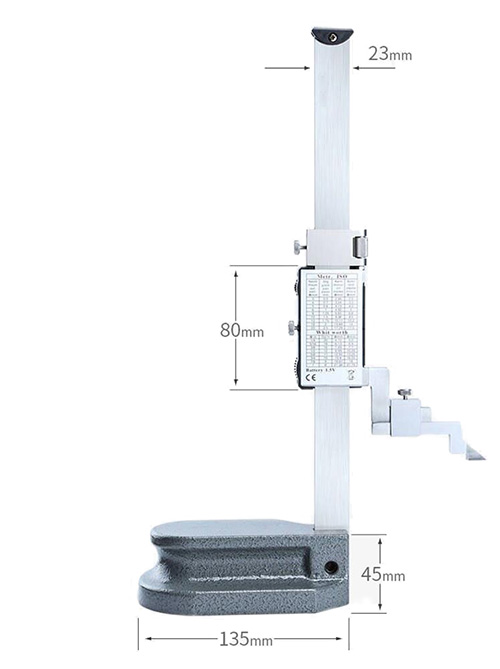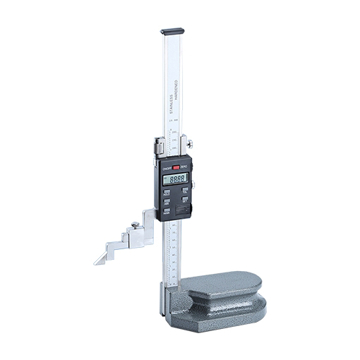Height Gauge
0-1000mm Digital Height Gauge, 0.01mm
0-200mm Digital Height Gauge, 0.01mm
0-300mm Digital Height Gauge, 0.01mm
0-500mm Digital Height Gauge, 0.01mm
0-600mm Digital Height Gauge, 0.01mm
Do you struggle with getting accurate height measurements in your projects? Look no further than the high-quality height gauges available on Tool.com online store. Our top-of-the-line height gauges provide precise measurements for your needs, with a range of up to 1000mm. These gauges use an LCD high-definition display, with clear and easy-to-read digital numbers. The 4CR13 stainless steel body can display both metric and imperial units. Plus, our height gauges are built with durability and convenience in mind, featuring a sturdy build and a portable design for ease of use on the go. When used with an indicator table, the measuring results are even more accurate. Don't let inaccurate height measurements hold you back - invest in a high-quality height gauge from Tool.com today.
What is a height gauge used for?
A height gauge, also known as a height measuring tool, is a precision measuring tool used to measure the height of objects with high accuracy. It is commonly used in industries such as machining, manufacturing, and engineering. Some of the most common uses of a height gauge include:
- Measuring the height of workpieces: A height gauge is used to accurately measure the height of workpieces to ensure that they meet the required specifications. This is particularly important in machining and manufacturing where even small variations in height can affect the quality and accuracy of the finished product.
- Setting up machines: Height gauges are used to set up machines such as lathes, milling machines, and grinders to ensure that the workpiece is at the correct height and angle for the machining operation.
- Checking the height of tools: Height gauges are also used to check the height of cutting tools such as drill bits, end mills, and reamers to ensure that they are the correct height for the machining operation.
- Measuring the thickness of materials: In addition to measuring the height of objects, height gauges can also be used to measure the thickness of materials such as sheet metal and plastic.
- Checking the flatness of surfaces: Some height gauges are equipped with a dial indicator that can be used to check the flatness of surfaces by measuring the distance between the surface and the gauge.

How does a digital height gauge work?
A digital height gauge is a precision measuring instrument used to measure the height of objects with high accuracy. It consists of a base, a vertical column, and a sliding carriage that moves up and down the column. The digital height gauge uses an electronic sensor to measure the distance between the base and the top surface of the object being measured.
- The electronic sensor in a digital height gauge is typically a linear encoder or a capacitive sensor. The linear encoder works by using a magnetic strip and a sensor to detect the movement of the carriage along the column. As the carriage moves up and down the column, the magnetic strip on the column produces a signal that is detected by the sensor and converted into a digital reading.
- The capacitive sensor works by measuring the distance between two plates. One plate is located on the carriage, and the other plate is located on the column. As the distance between the plates changes, the capacitance of the sensor changes, which is detected by the electronics and converted into a digital reading.
- The digital reading is displayed on a digital screen located on the height gauge. The screen typically displays the height reading in millimeters or inches, depending on the user's preference. Some digital height gauges also have features such as data output, hold function, and zero setting to make them easier to use and more convenient.
How accurate is a height gauge?
The accuracy of a height gauge depends on several factors, such as the type of height gauge, the quality of the components, and the calibration of the gauge. In general, height gauges are designed to provide high levels of accuracy, often within a few micrometers or even better.
For example, digital height gauges with a resolution of 0.01mm (0.0005 inches) can typically provide an accuracy of +/- 0.02mm (0.001 inches) or better. High-precision height gauges with a resolution of 0.001mm (0.00005 inches) can provide an accuracy of +/- 0.003mm (0.0001 inches) or better.
However, it is important to note that the accuracy of a height gauge can be affected by several factors, such as environmental conditions, the user's technique, and the condition of the measuring surfaces. To ensure the highest level of accuracy, it is essential to use the height gauge correctly, maintain it properly, and have it calibrated regularly by a qualified professional.
How to read a digital height gauge?
Reading a digital height gauge is a simple process, but it is important to use the gauge correctly to ensure accurate measurements. Here are the general steps for reading a digital height gauge:
- Turn on the digital height gauge: Most digital height gauges have an on/off button located on the display or the main body of the gauge. Press the button to turn on the gauge.
- Zero the gauge: Place the height gauge on a flat and level surface, and then press the "zero" button or use the zero function to set the gauge to zero. This will ensure that any subsequent measurements are relative to the surface of the workpiece.
- Position the gauge: Position the gauge on the workpiece, making sure that the base of the gauge is flat and level. Gently press the gauge against the surface of the workpiece.
- Read the measurement: The digital height gauge will display the height measurement on the digital screen. Some digital height gauges have a hold function that will freeze the reading on the display for easier recording.
- Remove the gauge: After taking the measurement, remove the gauge from the workpiece and turn off the gauge if necessary.
It is important to note that the specific steps for reading a digital height gauge may vary depending on the model and manufacturer. Always refer to the user manual for specific instructions on how to use and read your digital height gauge.






